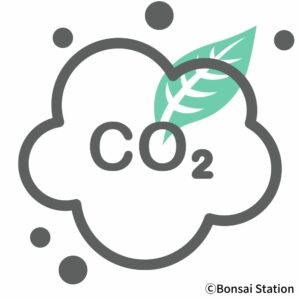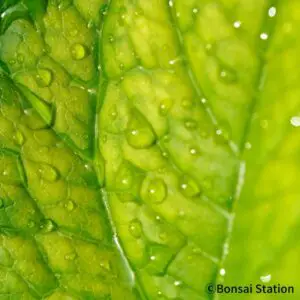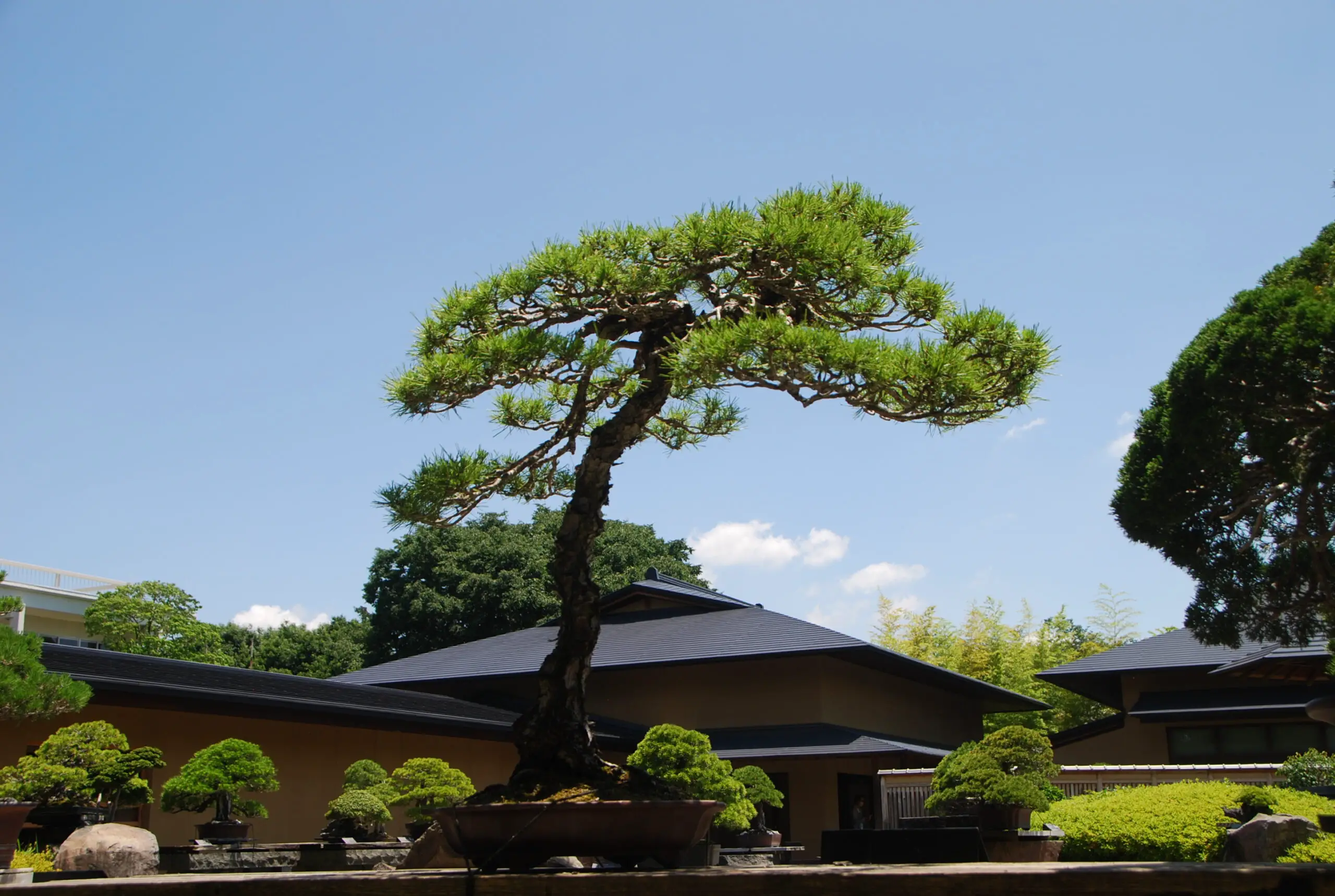Mini bonsai trees are tiny and seem like a pretty good fit for interior plants. But this is a common misconception.
Except for a very few indoor bonsai species like ficus, mini bonsai trees, as a general rule, should be kept outside because they need plenty of direct sunlight, circulating fresh air and morning dew for their growth.
Should Mini Bonsai Trees Kept Outside?
Mini bonsai trees should be kept outside as they need the following to grow healthy;
- plenty of direct sunlight
- fresh air with enough airflow and
- morning dew.
Here’s why.
How plants create energy

As plants do not eat food as animals do, they need to create it themselves through the process called photosynthesis. Plants use sunlight as well as carbon dioxide and water to create their energy source, glucose (sugar). This glucose provides the energy they need to grow and survive.
Processes of photosynthesis
There are three steps where photosynthesis creates energy.
- A light-dependent reaction: sunlight is converted to other forms of energy.
- A light-independent reaction: carbon dioxide is pulled from the air and combined with the energy they produced during the first step to create glucose.
- This glucose is broken down and used to create energy for growth or repair damages.
So sunlight, carbon dioxide and water are crucial for plants’ survival; and so for mini bonsai trees.
Mini bonsai needs direct sunlight
Do mini bonsai trees need direct sunlight?
Common bonsai species such as juniper, jade, oak, maple and cherry are the kind of plants that only thrive outside because they are photophilic plants; i.e. plants that grow in open places and cannot withstand a long period of time in the shade.
Photophilic plants like mini bonsai trees need on average 35,000 to 40,000 lux of light density, which is normally attainable only by keeping them outside.
Can I keep my mini bonsai tree inside?
Mini bonsai trees would generally not survive indoors as the brightest room at home is the kitchen with 500 lux on average as shown in the table below, vs. their needs of 35,000 to 40,000 lux.
The average lighting level in the US.
| Room type | Light intensity (lux) |
| Work station at offices | 500 |
| Kitchen | 500 |
| Dining area | 150-200 |
| Restroom | 200 |
(source: US General Services Administration- link here)
The only viable option without dedicated artificial light sources is alongside the window or balcony where they get at least 3 hours of sunlight a day.
Artificial light sources for mini bonsai trees will fix this problem but they need constant airflow as well.
Mini bonsai needs fresh air
How air movement helps photosynthesis

Importance of carbon dioxide
For plants’ photosynthesis, carbon dioxide in the air is necessary to convert itself and water into various organic chemicals which are used to grow and store energy. This means they need a constant supply of new carbon dioxide coming into their growing space. Without moving air, carbon dioxide can be rapidly removed from the surrounding air by photosynthesis.
Generally, a drop in carbon dioxide level below the normal atmospheric concentration means less photosynthesis, which leads to unhealthy growth or no growth at all.
If you keep a bonsai tree indoors, fresh air would not be moving sufficiently into the plant leaves to replenish the carbon dioxide they use for photosynthesis.
Plants in a confined space (greenhouse)
It has long been known that the plants in a greenhouse do not thrive well without enough air circulation.
To examine this phenomenon, scientists experimented the effect on the plants in a confined chamber if an increase of the CO2 concentration above the atmospheric level as well as air circulation positively affects the photosynthetic rates.
The result was that the average photosynthetic rates were 1.6 to 2.1 times higher in the growth chambers with increased CO2 concentration and air circulation.
Importance of oxygen

Plant roots respirate. Roots need oxygen to burn carbohydrates for the energy to grow and repair. In fact, the main purposes of the drainage holes in the bonsai pot are to prevent the tree from drowning in water and help the soil aerate.
What is root respiration?
In root systems, oxygen in soil diffuses into the roots and gets transported to all parts of the roots. During this respiration, plant roots use glucose made by photosynthesis for their various functions, like nutrient uptake and maintaining and growing their tissues. The carbon dioxide formed during respiration is then released into the soil, diffusing through the pores into the atmosphere.
Why is root respiration important?
Root respiration serves three purposes;
- roots’ maintenance
- roots’ growth
- roots’ rhizosphere (microbe storehouse)
1. Maintenance
Maintenance respiration is the energy, generated by respiration, which is necessary to keep the roots alive.
2. Growth
Root growth respiration provides energy for growing roots and new tissues.
3. Rhizosphere
Rhizospheric respiration is the respiration of microbes living in the rhizosphere (the soil zone around roots). The microbes in the rhizosphere, which use root fluids for their respiration, play an important role in nutrient cycling and maintaining soil fertility.
Without airflow, roots cannot get enough oxygen for root respiration.
Mini bonsai needs morning dew
During the nighttime, moisture in the humid air forms dew. Morning dew reduces water stress for mini bonsai trees through two main processes;
- prevent losing water through leaves
- act as a water source
They also need water to move the energy they create during the night.
Why do plants need water at night?

To prevent losing water
Water is evaporated through the leaves in a process called transpiration, which keeps plants from overheating. It is commonly assumed that transpiration does not occur at night but it does. In fact, for some species and circumstances, nighttime leaf water loss constituted a significant fraction of total daily water use.
In general, water deposited on leaves such as rain reduces transpiration. During nighttime when mini bonsai trees continue to lose water through transpiration, morning dew forms a protective barrier on the leaves; transpiration will not occur until the dew evaporates.
To water itself
Plants can actually absorb water directly through their leaves. Morning dews can be a source of hydration, though it is not a very efficient way compared to absorbing water through roots.
When water condenses on the leaf during high humidity, such as morning dew, bonsai trees can take in some of that surface water and keep them hydrated.
Morning dew also gives moisture to the soil, the water of which the roots can suck up.
To move energy
Nutrients of plants are dissolved in water and move from areas of high concentration, like the roots, to areas of lower concentration, such as the blooms, stem and leaves, for growth and reproduction.
Plants also grow during nighttime as in the daytime. For that, they use the energy they produced during the day through photosynthesis and water to carry the nutrients they need.
Do mini bonsai trees like humidity?

Except for mini bonsai trees made from tropical trees, they do not particularly like humidity. They need water to create energy and grow at an adequate level and not high humidity like in tropical rain forests.
—–
Reference
Thongbai, P., et. al. “CO2 and air circulation effects on photosynthesis and transpiration of tomato seedlings”. Scientia Horticulturae. Volume 126, Issue 3, 30 September 2010, Pages 338-344. (Link here)
Dawson TE, Burgess SS, Tu KP, Oliveira RS, Santiago LS, Fisher JB, Simonin KA, Ambrose AR. Nighttime transpiration in woody plants from contrasting ecosystems. Tree Physiol. 2007 Apr;27(4):561-75. doi: 10.1093/treephys/27.4.561. PMID: 17241998. (link here)
Tjosvold, A. “Maximize photosynthesis with moving air”. Agriculture and Natural Resources, University of California. October 17, 2018. (link here)
Trimble, S. “Root Respiration: Importance and Applications”. CID Bio-Science. November 16, 2021.



